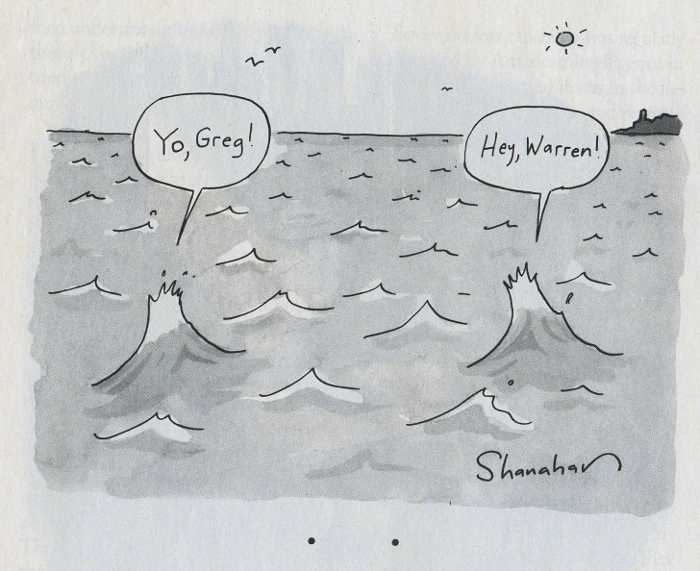FWP:
SETS == KYA
DROP/OCEAN: {21,8}
For Nazm and most of the other commentators, the elements (drop and wave and bubble) are meaningless, and only the whole (the sea) has meaning. For Faruqi, not only are the elements meaningless, but the whole that depends upon them is therefore meaningless too. I agree that these conclusions can indeed be drawn from the verse.
But what I really enjoy about it is the back-and-forthness, the ambivalence of its perspective. Look at the range of meanings of mushtamil , and of namuud . What exactly is the relationship of the vast sea to the tiny drops, waves, bubbles? Putting everything together, here are some of the main possibilities I think the verse opens up.
(1) The drop (and, by extension, the wave and the bubble) happily surrenders itself to the warm embrace of the sea, knowing its tiny personal 'self' is nothing apart from the great original whole. 'Here', in the sea, it joyously and mystically merges with its origin. Or perhaps it continues to have a limited and contingent life upon which it sets no value. This is the mood of {21,8}.
(2) The drop and wave and bubble are remorselessly swallowed up by the omnipotent sea. They are deprived of their individuality and their very being, so that there's literally nothing left of them and their own desires, and only the sea exists, impersonally rolling on forever. 'Here', in the sea, all lesser phenomena have been obliterated-- in them, what value is there, kyaa dharaa hai ?
(3) The sea itself is the reverse of omnipotent. In fact, it's nothing-- it's just a name for a collection of drops, and waves, and bubbles. To avoid the trouble of having many names for the parts (and what use are such names anyway?), we just give them the collective name of 'sea'. 'Here'-- that is, as we in the human world observe the sea that surrounds us-- we don't need to use the specialized names of the parts.
(4) The drop, wave, bubble, sea-- all are nothing, 'here' in the state of mystical transcendence in which we observe them. How foolish to worry about minor, evanescent concepts and entities! Of what use are any of them, anyway, compared to the worlds to which one has access as one approaches the divine presence?
(5) When we try to grasp or pick up a drop, wave, bubble, it runs out of our fingers before we even have time to close our hand. What can our hand retain of any of these visible, fascinating, even powerful, entities? And if our hand can't grasp them, can our mind really grasp them either? Don't they all melt away into the sea, into sheer water? And of course, we can't grasp water either.
So where does that leave us? In the usual Ghalibian mystical / emotional / intellectual quandary, ricocheting around among irreconcilable and unresolvable possibilities, savoring the mental pinball game. With wonder and admiration for what this poet can achieve.
As Hali points out, the idiom of kyaa dharaa hai works beautifully here, both with its colloquial meaning ('of what value, what use?') and literally ('what is grasped/held?').
And in this connection, it's also a pleasure to notices the well-exploited nuances of the 'kya effect' in the second line, since each of the three possibilities has significant resonances of its own.
Compare Mir's own brilliant questions about the parts of the sea: M{760,8}.


Hali:
An allegory for the oneness of Being and the multiplicity of illusory forms is the triviality and worthlessness of drop and wave and bubble. In a common idiom it is put like this: yahaa;N kyaa dharaa hai ['here, of what use is it?!']. It is the height of rhetoric [balaa;Gat].
==Urdu text: Yadgar-e Ghalib, p. 150